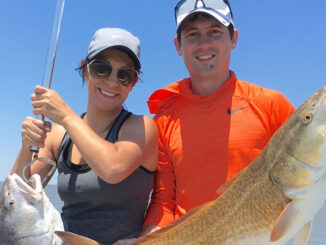
Don’t overlook this simple tried and true lure for big redfish
As early as the late 17thcentury, Scandinavian fishermen hammered metal kitchen spoons into fishing lures.
In the early 19th century, young J.T. Buel dropped his spoon into the water while eating lunch. As he watched it flutter down, a big fish smacked it. Probably when his mother wasn’t looking, the youngster swiped another spoon from the kitchen and fashioned it into a fishing lure.
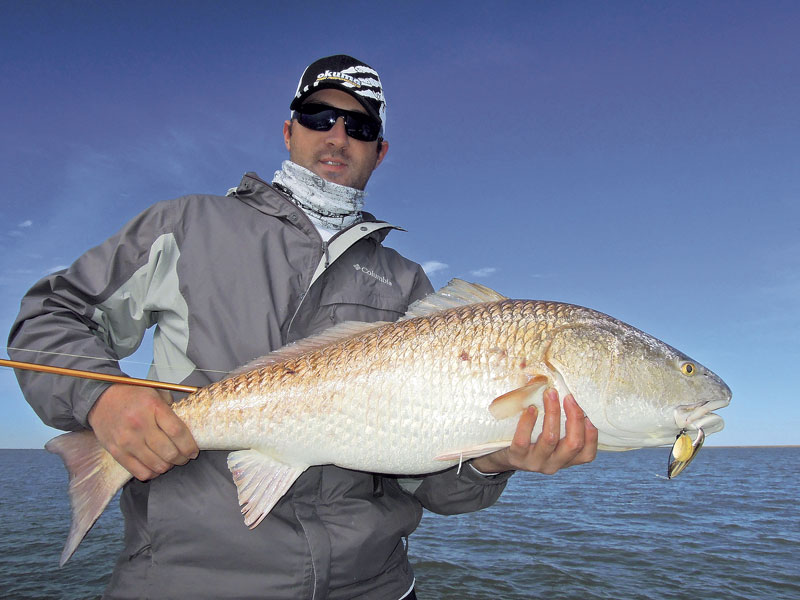
Buel began making more spoon lures and sold them for years before he obtained a patent on the Buel Spoon in 1852, the first patent awarded for any fishing lure commercially sold in the United States. Spoons remain popular today for both fresh and saltwater fishing because they still work.
“A spoon is a tried-and-true classic that’s still hard to beat,” proclaimed Sonny Schindler with Shore Thing Fishing Charters (228-342-2206, www.shorethingcharters.com) in Bay St. Louis, Miss. “It’s a very simple bait, so it’s hard to improve upon it, but it works so well. There’s a sweet spot when a spoon gets moving just right with that constant vibrating. Even the most unskilled fisherman will know when a redfish grabs a spoon.”
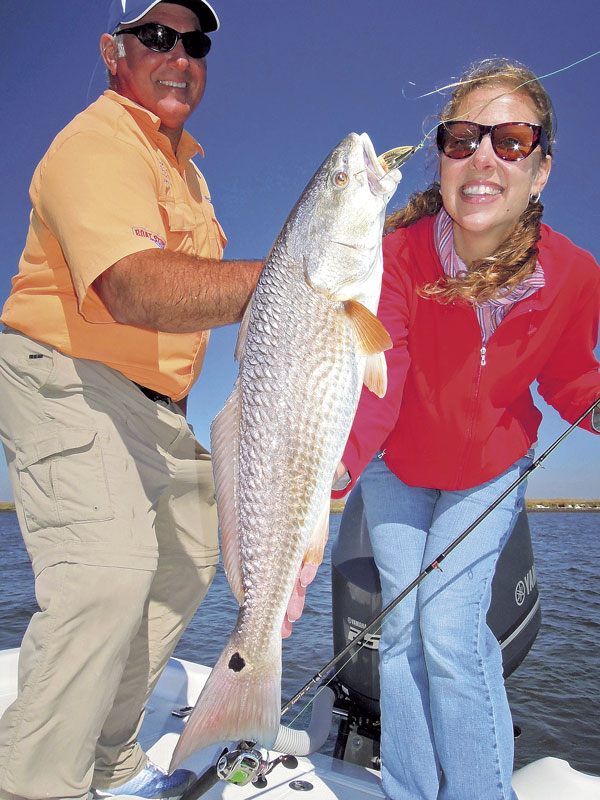
The Silver Minnow
One of the most popular spoons today, the Johnson Silver Minnow dates essentially unchanged to 1920 and remains a legendary redfish temptation. Despite the name, the spoon invented by Louis Johnson comes in varied colors, but for many saltwater anglers, only one color matters for catching bayou copper — gold! A metal arm helps deflect weeds and snags so people can fish it in places with thick grass or over oyster beds and other redfish-holding structures without snagging.
“I personally use nothing but weedless gold spoons,” said Mike Frenette, a professional redfish angler and guide with The Redfish Lodge of Louisiana (504-782-0924, Laredfish.com) in Venice. “I’ve used spoons in many different states and different habitats. Some people swear by black in really clear water. Some people like the silver or chrome.”
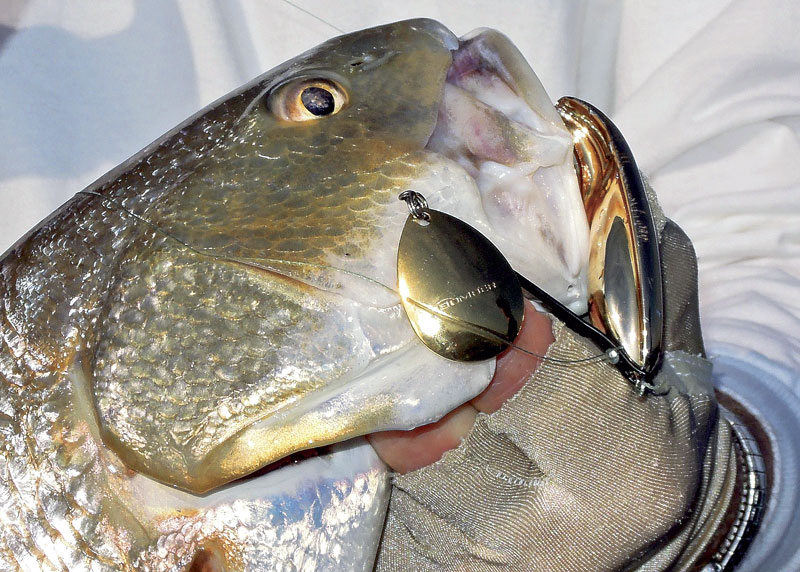
Anyone, even a child or beginner fisherman, can use a spoon to fish from the surface to the bottom and catch reds. With little effort on the part of the angler, spoons naturally create wobbling action and can work at any depth. Crank the reel faster or hold the rod tip higher to make a spoon run closer to the surface. Or barely turn the reel to slow roll the bait just off the bottom.
“The beauty of a spoon is it’s so easy to work,” said Ryan Lambert with Cajun Fishing Adventures (985-785-9833, www.cajunfishingadventures.com) in Buras. “Anybody can catch redfish with a spoon in so many ways. If I have a novice on board who can’t handle certain baits, I always put a spoon on the line for that person. Just throw it as far as possible and reel it in. I’ve seen people catch more than 100 redfish in a day on a spoon. It’s a great lure for anybody to use.”
Lots of anglers don’t need to jerk the rod or add more dynamic action, but some people pause reeling to let the spoon sink a few feet like a dying baitfish before resuming the retrieve. People can even vertically jig spoons. Some people even cast tiny spoons with fly tackle. All of these ways catch fish.

It’s the wobble
The wobbling gives off considerable flash and vibrations that fish can see and feel, even while fluttering to the bottom. Many people think the wobbling reminds redfish of a crab swimming through the water with its rounded rear swimmer fins flashing back and forth. A redfish likes nothing better than to crunch a crab.
“I use spoons mainly when the grass is up and the crabs are out,” Lambert said. “It’s best from May through October when there’s a lot of aquatic vegetation in the water and reds are feeding on crabs. When redfish hit a crab, they try to get it in the back of its mouth by their crushers. Look at a crab in a redfish’s belly. It’s crushed. When reds hit a spoon, they are rocking it!”
When a big redfish grabs a wobbling spoon, it almost hooks itself, especially if it struck a moving bait. For good measure, make a good hook set or two on that rugged fish. Anglers can accentuate the lure’s wobbling action by adding a split ring and a swivel to the nose.
“It the bait doesn’t already come with one, I recommend anglers put a small split ring on the eye and add a swivel,” Frenette said. “That’ll keep the line from twisting. If the line starts to twist, people won’t be able to cast as far. The great thing about a spoon is it can cast like the dickens. A person can sling them out there and cover a lot of water wobbling the whole time. If I’m coming up on a point or I know that there are oysters between the point and my boat, I don’t want to get in there and disturb the fish so I’ll throw a spoon through that area.”
Since the heavy, compact baits can sail long distances, they make superb search baits. Generally, the farther from the boat one can cast, the more fish that person will catch. Even if the fish doesn’t strike the spoon, it might cause it to move and give away its location. Sometimes, one red might even try to take a bait out of a hooked spot-tailed cousin’s mouth.
“My favorite time to throw a spoon is when I’m scouting for fish,” Schindler said. “If I’m in an area that I think has redfish, I’ll throw a spoon to cover as much water as I can faster than most other baits.”
Let it sink
Frequently, big redfish follow baits for long distances before finally smashing them right at the boat. If a redfish follows, but doesn’t strike, pause the retrieve to make the bait sink a few feet to imitate a wounded baitfish.
“When redfish just slap at a spoon, slow that retrieve down or stop it for a couple seconds,” Frenette said. “Then start slowly retrieving it again because they’re looking at it. I’ve had redfish slap at a spoon two or three times before grabbing it. I had times when I stopped the retrieve to let the spoon fall to the bottom. Fish pick it up right off the bottom. When they do grab a spoon, reds just about jerk the rod out of someone’s hands.”
For added enticement and color, sweeten a spoon with a soft-plastic trailer. A split trailer or one with claws mimics a crab works well. Fish a spoon with a trailer over the grass tops like a buzzbait for explosive topwater strikes or reel it steadily just off the bottom. Hopping one off the bottom could imitate a crab.
“I sometimes tip spoons with a chartreuse curly tail to make it vibrate more and cause more of a disturbance in the water,” Schindler said. “Usually, I make a slow retrieve to keep it just off the bottom. Most of the stuff we fish has shells or grass on the bottom.”
Many anglers work gold spoons through weedy areas like in the Mississippi River Delta. Like the original Johnson Silver Minnow, many spoons come equipped with weed guards so they can easily slip through thick vegetation or over oyster beds. Around oysters and other hard cover, slow roll spoons off the bottom so the metal lure clanks against the objects.
“My favorite way to fish is in the shallow marsh ponds looking for reds,” Schindler said. “Most spoons have weedless features. If I’m in a new pond and don’t know what’s in it, there might be shells, grass or something else in it that can hang up other lures. With a spoon, I can get in and out of it without wasting time and losing tackle.”
Fish the shorelines
When fishing marshy shorelines, throw spoons into any pockets or irregularities in the grass and work them out toward the boat. Also run spoons parallel to marshy shorelines, jetties, reef edges or next to bridge or dock pilings and across points. Some spoons come with little plastic covers slipped over the swivel or eye to make them even more weedless and snagless.
If a spoon doesn’t already come with a metal weed guard, place a length of monofilament line from the eye to the hook barb. Another way, loop a rubber band through the eye and stretch it back to the hook barb to make a spoon weedless.
Because anglers typically fish spoons around thick weeds or rough objects, throw it on tough 30-pound-test braided line. Tie on about four feet of a 20-pound-test monofilament or fluorocarbon leader to the braid. In murky water, use shorter leaders. For exceptionally clear water, use longer leader. To make the longest casts, throw spoons on a 7 to 7.5 foot medium action rod.
Anglers can catch redfish with spoons anywhere they can find the spot-tailed marauders. Almost overlooked among the plethora of colorful plastics and other baits, spoons look so simple, but they still catch fish and have been for centuries.
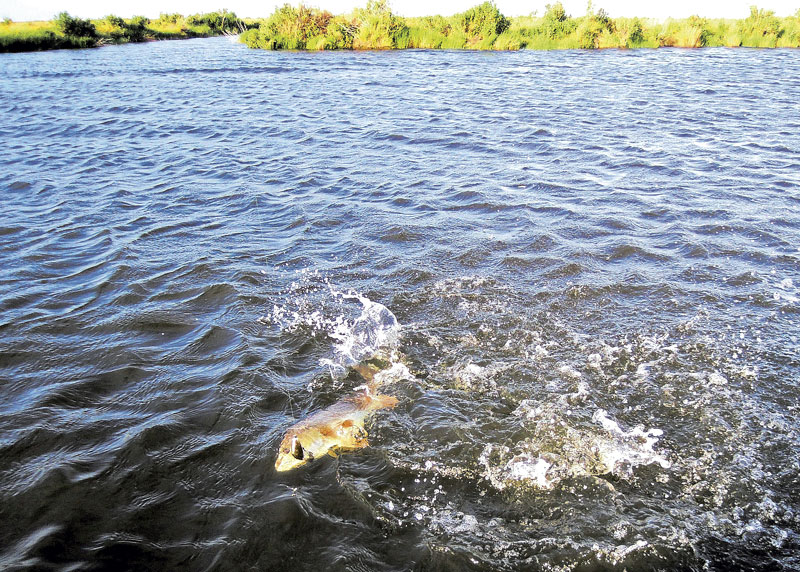
Mississippi has plenty of coastal spoon spots
Anglers can catch redfish throughout coastal Mississippi, but two areas really stand out — the Pascagoula River Delta and the marshes between Bayou Caddy near Waveland and East Pearl River. Some marshes and bayous feed into the Back Bay of Biloxi. The Tchoutacabouffa and Biloxi rivers plus other streams flow into the Back Bay.
Old Fort Bayou and its tributaries flow into the eastern side, creating a good place to look for redfish. Other marshes surround Bay St. Louis. People can also fish the barrier islands just offshore.
“The marshes around Back Bay and Bay St. Louis are good places to throw spoons,” said Sonny Schindler. “The Bayou Caddy area by Lakeshore has some good places to throw spoons. The Heron Bay and Ansley areas are also good. Cat Island has marshy bayous in it. We also use spoons a lot around Cat Island.”
In southeastern Mississippi, the Pascagoula River creates one of the richest estuaries on the Gulf Coast. Numerous channels flow through a marsh dotted by small lakes. Anglers can also fish similar marshes and islands near the Alabama line.
Many people also fish Graveline Bayou area southwest of Gautier.
